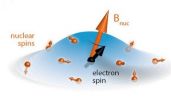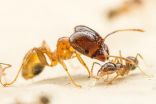(Press-News.org) CAMBRIDGE, MA -- Yeast are commonly used to transform corn and other plant materials into biofuels such as ethanol. However, large concentrations of ethanol can be toxic to yeast, which has limited the production capacity of many yeast strains used in industry.
"Toxicity is probably the single most important problem in cost-effective biofuels production," says Gregory Stephanopoulos, the Willard Henry Dow Professor of Chemical Engineering at MIT.
Now Stephanopoulos and colleagues at MIT and the Whitehead Institute for Biomedical Research have identified a new way to boost yeast tolerance to ethanol by simply altering the composition of the medium in which the yeast are grown. They report the findings, which they believe could have a significant impact on industrial biofuel production, in today's issue of the journal Science.
Ethanol and other alcohols can disrupt yeast cell membranes, eventually killing the cells. The MIT team found that adding potassium and hydroxide ions to the medium in which yeast grow can help cells compensate for that membrane damage. By making these changes, the researchers were able to boost yeast's ethanol production by about 80 percent. They also showed that this approach works with commercial yeast strains and other types of alcohols, including propanol and butanol, which are even more toxic to yeast.
"The more we understand about why a molecule is toxic, and methods that will make these organisms more tolerant, the more people will get ideas about how to attack other, more severe problems of toxicity," says Stephanopoulos, one of the senior authors of the Science paper.
"This work goes a long way to squeezing the last drop of ethanol from sugar," adds Gerald Fink, an MIT professor of biology, member of the Whitehead Institute, and the paper's other senior author. Postdoc Felix Lam is the paper's lead author, and graduate student Adel Ghaderi also contributed to the study.
Reinforcing cell defenses
The research team began this project searching for a gene or group of genes that could be manipulated to make yeast more tolerant to ethanol, but this approach did not yield much success. However, when the researchers began to experiment with altering the medium in which yeast grow, they found some dramatic results.
By augmenting the yeast's environment with potassium chloride, and increasing the pH with potassium hydroxide, the researchers were able to dramatically boost ethanol production. They also found that these changes did not affect the biochemical pathway used by the yeast to produce ethanol: Yeast continued to produce ethanol at the same per-cell rate as long as they remained viable. Instead, the changes influenced their electrochemical membrane gradients — differences in ion concentrations inside and outside the membrane, which produce energy that the cell can harness to control the flow of various molecules into and out of the cell.
Ethanol increases the porosity of the cell membrane, making it very difficult for cells to maintain their electrochemical gradients. Increasing the potassium concentration and pH outside the cells helps them to strengthen the gradients and survive longer; the longer they survive, the more ethanol they make.
"By reinforcing these gradients, we're energizing yeast to allow them to withstand harsher conditions and continue production. What's also exciting to us is that this could apply beyond ethanol to more advanced biofuel alcohols that upset cell membranes in the same way," Lam says.
The researchers found that they could also prolong survival, but not as much, by engineering the yeast cells to express more potassium and proton pumps, which are located in the cell membrane and pump potassium in and protons out.
Industrial relevance
Before yeast begin their work producing ethanol, the starting material, usually corn, must be broken down into glucose. A significant feature of the new MIT study is that the researchers did their experiments at very high concentrations of glucose. While many studies have examined ways to boost ethanol tolerance at low glucose levels, the MIT team used concentrations of about 300 grams per liter, similar to what would be found in an industrial biofuel fermenter.
"If you really want to be relevant, you've got to go to these levels. Otherwise, what you learn at low ethanol levels is not likely to translate to industrial production," Stephanopoulos says.
In more recent experiments, the MIT researchers have used this method to bump ethanol productivity even higher than reported in the Science paper. They are also working on using this approach to boost the ethanol yield from various industrial feedstocks that, because of starting compounds inherently toxic to yeast, now have low yields.
INFORMATION:
The research was funded by the MIT Energy Initiative and the Department of Energy.
How can we tell when someone has fallen asleep? To answer this question, scientists at Massachusetts General Hospital have developed a new statistical method and behavioural task to track the dynamic process of falling asleep.
Dr Michael Prerau, Dr Patrick Purdon, and their colleagues used the evolution of brain activity, behaviour, and other physiological signals during the sleep onset process to automatically track the continuous changes in wakefulness experienced as a subject falls asleep.
The study, publishing today in PLOS Computational Biology, suggests that it ...
VIDEO:
Dr. Frans Leenen, from the University of Ottawa Heart Institute, discusses the importance of these new findings.
Click here for more information.
Ottawa, ON and Baltimore, MD, October 2, 2014—New research by scientists at the Ottawa Heart Institute and the University of Maryland School of Medicine (UM SOM) has uncovered a new pathway by which the brain uses an unusual steroid to control blood pressure. The study, which also suggests new approaches for treating high blood ...
Biologists from the University of York have compiled two new datasets on insect evolution, revealing that metamorphosing insects diversify more quickly than other insects and are therefore the biggest contributors to the evolution of insect diversity.
Both funded by the Natural Environment Research Council (NERC), the first dataset is a complete fossil catalogue showing timescales of origination and extinction of different families of insects. Working with the Natural History Museum and National Museums Scotland, former PhD student Dr David Nicholson collated a database ...
By combining data from two high-energy accelerators, nuclear scientists have refined the measurement of a remarkable property of exotic matter known as quark-gluon plasma. The findings reveal new aspects of the ultra-hot, "perfect fluid" that give clues to the state of the young universe just microseconds after the big bang.
The multi-institutional team known as the JET Collaboration, led by researchers at the U.S. Department of Energy's Lawrence Berkeley National Lab (Berkeley Lab), published their results in a recent issue of Physical Review C. The JET Collaboration ...
As the Supreme Court of the United States begins its fall 2014 session this month, it faces decisions on several "blockbuster" cases, including freedom of speech, religious freedoms in prison, pregnancy discrimination and a possible decision on gay marriage.
Just don't expect any of these decisions until next June, just before the court's session ends.
New research from the Washington University in St. Louis School of Law finds big, or "blockbuster," cases are disproportionately decided at the end of June, just before the court's summer recess.
"We knew that more than ...
Older parents, birth defects, maternal nutrition and childhood exposure to CT scans and pesticides are increasingly being associated with brain tumors in children, according to new research from the Brown School at Washington University in St. Louis.
Brain and central nervous system tumors are the second leading cause of cancer death in children.
A team of researchers, led by Kimberly Johnson, PhD, assistant professor of social work at the Brown School, a member of the Institute for Public Health and a research member of Siteman Cancer Center, examined studies published ...
Where are the quantum computers? Aren't they supposed to be speeding up decryption and internet searches? After two decades of research, you still can't find them in stores. Well, it took two decades or more of research dedicated to semiconductors and circuit integration before we had digital computers. For quantum computers too it will take technology more time to catch up to the science
Meanwhile, research devoted to exploring bizarre quantum phenomena must continue to overcome or reduce a litany of practical obstacles before quantum computing can be realized. ...
Montréal, October 2, 2014 – Scientists at the IRCM discovered a mechanism that promotes the progression of medulloblastoma, the most common brain tumour found in children. The team, led by Frédéric Charron, PhD, found that a protein known as Sonic Hedgehog induces DNA damage, which causes the cancer to develop. This important breakthrough will be published in the October 13 issue of the prestigious scientific journal Developmental Cell. The editors also selected the article to be featured on the journal's cover.
Sonic Hedgehog belongs to a family of proteins that gives ...
CHAMPAIGN, Ill. — The big-headed ant (Pheidole megacephala) is considered one of the world's worst invasive ant species. As the name implies, its colonies include soldier ants with disproportionately large heads. Their giant, muscle-bound noggins power their biting parts, the mandibles, which they use to attack other ants and cut up prey. In a new study, researchers report that big-headed ant colonies produce larger soldiers when they encounter other ants that know how to fight back.
The new findings appear in the Biological Journal of the Linnean Society.
Big-headed ...
London, United Kingdom, October 2, 2014 – Despite decades of research, scientists have yet to pinpoint the exact cause of nodding syndrome (NS), a disabling disease affecting African children. A new report suggests that blackflies infected with the parasite Onchocerca volvulus may be capable of passing on a secondary pathogen that is to blame for the spread of the disease. New research is presented in the International Journal of Infectious Diseases.
Concentrated in South Sudan, Northern Uganda, and Tanzania, NS is a debilitating and deadly disease that affects young ...




